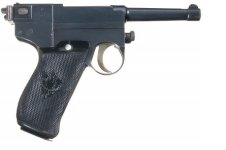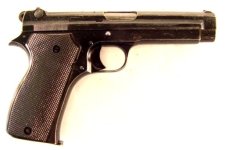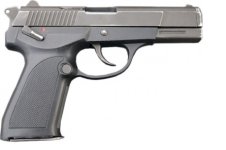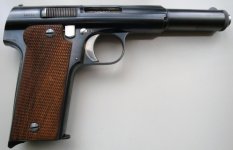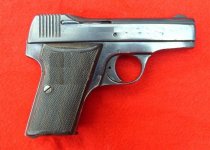You are using an out of date browser. It may not display this or other websites correctly.
You should upgrade or use an alternative browser.
You should upgrade or use an alternative browser.
What the heck
- Thread starter Ozzieman
- Start date
Sorry about the dooblee
You are right Again
401 Glisenti Model 1910
https://en.wikipedia.org/wiki/Glisenti_Model_1910
The Glisenti Model 1910 was a 9mm calibre semi-automatic service pistol produced by the Italian company Societa Siderugica Glisenti.[1] It was put in production in 1910 to replace the aging Bodeo Model 1889. It saw extensive service in World War I and World War II with the Italian Army. The Model 1910 has a complex and weak firing system which mandates that the pistol ought to use weaker cartridges than pistols of comparable caliber.
Development[edit]
The creation of a service pistol to supplant the Bodeo Model 1889 began to be rumored in late 1903.[2] The pistol was designed by Italian inventor Bethel Abiel Revelli.[3] Revelli spent multiple years developing a prototype before patenting his design to Societa Siderugica Glisenti of Turin.[2] The Glisenti company acquired the machinery to begin production from the United Kingdom in 1906 but sold the manufacturing rights to Metallurgica Brescia gia Tempini.[2]
Original Design[edit]
The Glisenti Model 1910 was originally designed to fire a 7.65×22mm bottle-neck cartridge.[2] The pistol being known as the Model 1906 began production in 1908.[2] The Model 1906 failed to impress the Italian Army and was requested to fire a round similar to the German 9×19mm Parabellum.[2] The redesign was named the Model 1910 and was formally adopted by the Italian Army. To reduce recoil[2] and because of the pistol's weak design,[1] the Model 1910 had to fire the 9mm Glisenti. The 9mm Glisenti is structurally similar to the 9×19mm Parabellum but has a reduced velocity.[2]
Design Details[edit]
Mechanics[edit]
The Model 1910 fires from a locked breech. When fired, the barrel and bolt recoil together. The barrel will stop in a rearward position. The bolt, unlocking itself, will then continue forward, stripping the chamber and driving the barrel forward again. After this action, a wedge will rise from the frame and lock the entire frame back into position.[1] This firing system wasn't strong and had to fire cartridges weaker than the comparable 9×19 Parabellum caliber.[1] The screw at the front of the frame, when undone will allow the removal of a plate on the left side of the pistol granting access to the moving parts within the pistol.[1] This design was not stiff enough to sufficiently support the left side of the barrel extension and after prolonged firing, the left plate was prone to loosening.[4] The only safety on the pistol was a small lever set in front of the grip.[4]
Replacement[edit]
Attempted Redesign[edit]
Metallurgica Brescia gia Tempini in 1912 attempted to improve the design of the Model 1910. The improved pistol, referred to as the Brixia, was submitted to the Italian Army for approval.[5] The Brixia had a strengthened frame and removed the grip safety but wasn't a big enough improvement to make a change in the Italian Army.[5] The Brixia was later to be sold to the civilian market but the outbreak of World War I led to the cancellation of the project.[5]
End of Service[edit]
The Glisenti remained in production until the early 1920s.[5] In increasing numbers from 1916 onward, the Glisenti began to be phased out by the Spanish produced Ruby pistol[4] and Beretta M1915.[5] The Beretta later became the official service pistol in the Italian Army in 1934. The Glisenti was declared obsolete the same year but saw limited service in World War II.[3]
You are right Again
401 Glisenti Model 1910
https://en.wikipedia.org/wiki/Glisenti_Model_1910
The Glisenti Model 1910 was a 9mm calibre semi-automatic service pistol produced by the Italian company Societa Siderugica Glisenti.[1] It was put in production in 1910 to replace the aging Bodeo Model 1889. It saw extensive service in World War I and World War II with the Italian Army. The Model 1910 has a complex and weak firing system which mandates that the pistol ought to use weaker cartridges than pistols of comparable caliber.
Development[edit]
The creation of a service pistol to supplant the Bodeo Model 1889 began to be rumored in late 1903.[2] The pistol was designed by Italian inventor Bethel Abiel Revelli.[3] Revelli spent multiple years developing a prototype before patenting his design to Societa Siderugica Glisenti of Turin.[2] The Glisenti company acquired the machinery to begin production from the United Kingdom in 1906 but sold the manufacturing rights to Metallurgica Brescia gia Tempini.[2]
Original Design[edit]
The Glisenti Model 1910 was originally designed to fire a 7.65×22mm bottle-neck cartridge.[2] The pistol being known as the Model 1906 began production in 1908.[2] The Model 1906 failed to impress the Italian Army and was requested to fire a round similar to the German 9×19mm Parabellum.[2] The redesign was named the Model 1910 and was formally adopted by the Italian Army. To reduce recoil[2] and because of the pistol's weak design,[1] the Model 1910 had to fire the 9mm Glisenti. The 9mm Glisenti is structurally similar to the 9×19mm Parabellum but has a reduced velocity.[2]
Design Details[edit]
Mechanics[edit]
The Model 1910 fires from a locked breech. When fired, the barrel and bolt recoil together. The barrel will stop in a rearward position. The bolt, unlocking itself, will then continue forward, stripping the chamber and driving the barrel forward again. After this action, a wedge will rise from the frame and lock the entire frame back into position.[1] This firing system wasn't strong and had to fire cartridges weaker than the comparable 9×19 Parabellum caliber.[1] The screw at the front of the frame, when undone will allow the removal of a plate on the left side of the pistol granting access to the moving parts within the pistol.[1] This design was not stiff enough to sufficiently support the left side of the barrel extension and after prolonged firing, the left plate was prone to loosening.[4] The only safety on the pistol was a small lever set in front of the grip.[4]
Replacement[edit]
Attempted Redesign[edit]
Metallurgica Brescia gia Tempini in 1912 attempted to improve the design of the Model 1910. The improved pistol, referred to as the Brixia, was submitted to the Italian Army for approval.[5] The Brixia had a strengthened frame and removed the grip safety but wasn't a big enough improvement to make a change in the Italian Army.[5] The Brixia was later to be sold to the civilian market but the outbreak of World War I led to the cancellation of the project.[5]
End of Service[edit]
The Glisenti remained in production until the early 1920s.[5] In increasing numbers from 1916 onward, the Glisenti began to be phased out by the Spanish produced Ruby pistol[4] and Beretta M1915.[5] The Beretta later became the official service pistol in the Italian Army in 1934. The Glisenti was declared obsolete the same year but saw limited service in World War II.[3]
Mike Irwin
Staff
"Right French 1935A, only in .32 French service cartridge (7.65 Longue), not 30 cal."
Well, sort of.
The 7.65x20 cartridge was a French development based on the .30 Pedersen cartridge (officially know as the .30 Auto Pistol Ball, Model of 1918).
The case was dimensionally identical, most commonly made from steel. The bullet was slightly lighter than the .30 Pedersen, and also commonly steel jacketed.
Both rounds used a .309-diameter bullet.
In case anyone is interested in shooting their MAS pistol, new brass has been available now and again, made by Bertram and sold by Midway. I've heard people say that you can use .32 S&W Long dies to load it.
Well, sort of.
The 7.65x20 cartridge was a French development based on the .30 Pedersen cartridge (officially know as the .30 Auto Pistol Ball, Model of 1918).
The case was dimensionally identical, most commonly made from steel. The bullet was slightly lighter than the .30 Pedersen, and also commonly steel jacketed.
Both rounds used a .309-diameter bullet.
In case anyone is interested in shooting their MAS pistol, new brass has been available now and again, made by Bertram and sold by Midway. I've heard people say that you can use .32 S&W Long dies to load it.
Buzzcook was correct in calling it the Modèle 1935 pistol
But Mikes addition gets him extra points.
https://en.wikipedia.org/wiki/Modèle_1935_pistol
Two similar but distinct French military pistols carry the designation "Model 1935", the model 1935A and the model 1935S. Both were designed to compete in the 1935–37 French military trials conducted by the Commission d’Experiences Techniques de Versailles to select a new sidearm. While similar in concept and design due to the specific requirements of the trials committee, they share no parts in common.
Description[edit]
Pistolet automatique modèle 1935A[edit]
The Pistolet automatique modèle 1935A (Automatic Pistol Model 1935A) or Modèle (Mle.) 1935 A is a semi-automatic pistol chambered for the 7.65mm Longue cartridge. It was developed by the Swiss Charles Petter (a former captain of French Foreign Legion), engineer of the French company Société Alsacienne de Constructions Mécaniques (SACM) and used by the French Army in several wars. It won the 1935–37 competition to produce the new French military sidearm. Initial production began in 1937, and the pistol began delivery to the French Army in late 1939, with a total of about 10,700 pistols built before German forces occupied the SACM factory in the summer of 1940. The Germans continued production of the 1935A, now designated the "Pistole 625 (f)", with about 23,850 pistols made for the German forces. Following the end of the German occupation of France in 1944, SACM resumed production of the 1935A for the French military, making a further 50,400 pistols. In total, about 84,950 1935A pistols were produced between October 1937 and February 1950.
In 1937, Switzerland’s Schweizerische Industrie Gesellschaft purchased a license from SACM for the 1935A, which became the basis for the development by SIG Sauer of the SIG P210.
Pistolet automatique modèle 1935S[edit]
The Pistolet automatique modèle 1935S (Automatic Pistol Model 1935S) or Modèle (Mle.) 1935 S is a semi-automatic pistol chambered for the 7.65mm Longue cartridge. It was designed by Manufacture d'armes de Saint-Étienne (MAS), a French government arsenal. It was a competitor in the 1935-37 French military trials to select a new sidearm, losing to the SACM 1935A. However, as France prepared for the looming war in Europe it became apparent that SACM production was inadequate to meet the military's needs. In 1938 additional contracts were given to MAS to produce the 1935S, and all production of the commercial MAB model D and MAPF "Unique" model 17 pistols was diverted to the military. MAS began initial delivery of the 1935S to the French military in early 1939, but production ceased after only about 1404 pistols were built when German forces occupied Saint-Étienne in the summer of 1940. MAS factory workers were able to hide key 1935S tooling and machinery before the Germans occupied the factory;[citation needed] as a result, unlike the 1935A, MAB D and Unique 17, the 1935S was not produced during the German occupation of France. Production resumed in 1944 after the end of the occupation. Since MAS was also a primary producer of French military rifles and light machine guns needed for the French colonial war in Indochina, production of the 1935S was shifted to other French arms producers in late 1944, after MAS had built of total of about 6,686 pistols. The other makers of the 1935S were M-F (Manufacture Française d’Armes et Cycles de Saint Étienne, aka ManuFrance) which built about 10,000 pistols in 1944–45; SAGEM (Societe d'Applications Generales d'Electricite et de la Mecanique), which built about 10,000 pistols in 1945–1953, and MAC (Manufacture Nationale d’Armes de Chatellerault), which built about 56,087 pistols in 1946–1956. MAC revised the 1935S safety to function as did the 1935A safety; this change was included in all MAC and SAGEM 1935S production starting in 1946, with the pistols marked 1935 S M1 starting in March 1947. In total, about 82,773 1935S pistols were produced between 1937 and 1956.
The 1935S directly inspired the design of the French service pistol that replaced the 1935A and 1935S, the MAC Mle 1950 in 9mm Parabellum.
But Mikes addition gets him extra points.
https://en.wikipedia.org/wiki/Modèle_1935_pistol
Two similar but distinct French military pistols carry the designation "Model 1935", the model 1935A and the model 1935S. Both were designed to compete in the 1935–37 French military trials conducted by the Commission d’Experiences Techniques de Versailles to select a new sidearm. While similar in concept and design due to the specific requirements of the trials committee, they share no parts in common.
Description[edit]
Pistolet automatique modèle 1935A[edit]
The Pistolet automatique modèle 1935A (Automatic Pistol Model 1935A) or Modèle (Mle.) 1935 A is a semi-automatic pistol chambered for the 7.65mm Longue cartridge. It was developed by the Swiss Charles Petter (a former captain of French Foreign Legion), engineer of the French company Société Alsacienne de Constructions Mécaniques (SACM) and used by the French Army in several wars. It won the 1935–37 competition to produce the new French military sidearm. Initial production began in 1937, and the pistol began delivery to the French Army in late 1939, with a total of about 10,700 pistols built before German forces occupied the SACM factory in the summer of 1940. The Germans continued production of the 1935A, now designated the "Pistole 625 (f)", with about 23,850 pistols made for the German forces. Following the end of the German occupation of France in 1944, SACM resumed production of the 1935A for the French military, making a further 50,400 pistols. In total, about 84,950 1935A pistols were produced between October 1937 and February 1950.
In 1937, Switzerland’s Schweizerische Industrie Gesellschaft purchased a license from SACM for the 1935A, which became the basis for the development by SIG Sauer of the SIG P210.
Pistolet automatique modèle 1935S[edit]
The Pistolet automatique modèle 1935S (Automatic Pistol Model 1935S) or Modèle (Mle.) 1935 S is a semi-automatic pistol chambered for the 7.65mm Longue cartridge. It was designed by Manufacture d'armes de Saint-Étienne (MAS), a French government arsenal. It was a competitor in the 1935-37 French military trials to select a new sidearm, losing to the SACM 1935A. However, as France prepared for the looming war in Europe it became apparent that SACM production was inadequate to meet the military's needs. In 1938 additional contracts were given to MAS to produce the 1935S, and all production of the commercial MAB model D and MAPF "Unique" model 17 pistols was diverted to the military. MAS began initial delivery of the 1935S to the French military in early 1939, but production ceased after only about 1404 pistols were built when German forces occupied Saint-Étienne in the summer of 1940. MAS factory workers were able to hide key 1935S tooling and machinery before the Germans occupied the factory;[citation needed] as a result, unlike the 1935A, MAB D and Unique 17, the 1935S was not produced during the German occupation of France. Production resumed in 1944 after the end of the occupation. Since MAS was also a primary producer of French military rifles and light machine guns needed for the French colonial war in Indochina, production of the 1935S was shifted to other French arms producers in late 1944, after MAS had built of total of about 6,686 pistols. The other makers of the 1935S were M-F (Manufacture Française d’Armes et Cycles de Saint Étienne, aka ManuFrance) which built about 10,000 pistols in 1944–45; SAGEM (Societe d'Applications Generales d'Electricite et de la Mecanique), which built about 10,000 pistols in 1945–1953, and MAC (Manufacture Nationale d’Armes de Chatellerault), which built about 56,087 pistols in 1946–1956. MAC revised the 1935S safety to function as did the 1935A safety; this change was included in all MAC and SAGEM 1935S production starting in 1946, with the pistols marked 1935 S M1 starting in March 1947. In total, about 82,773 1935S pistols were produced between 1937 and 1956.
The 1935S directly inspired the design of the French service pistol that replaced the 1935A and 1935S, the MAC Mle 1950 in 9mm Parabellum.
Scorch have you hacked my computer?
Good one I thought would last more than a couple of hours
190 QSZ-92
https://en.wikipedia.org/wiki/QSZ-92
The QSZ-92 (Chinese: 92式手枪; pinyin: Jiǔ Èr Shí Shoǔqiàng or Jiǔ Shí Èr Shi Shoǔqiàng; literally: "Type 92 Handgun") is a semi-automatic pistol designed by Norinco.
Development[edit]
The pistol operate is a recoil-operated, locked-breech and has a rotating barrel locking system, in which the barrel rotates on recoil to lock and unlock itself from the slide and the front part of the frame under the barrel is shaped as an accessory rail to accept laser sights or flash lights.
Its dual stack magazine holds fifteen of either 9×19mm Parabellum ammunition (QSZ-92-9) or twenty proprietary 5.8×21mm Chinese-made armor-piercing rounds with bottle-necked case and pointed bullets (QSZ-92-5.8), closely resembling the Belgian 5.7×28mm format.
The development of the QSZ-92 pistol began circa 1994 and it is now being adopted by the People's Liberation Army forces. The export variants (9mm version) include the CF-98 (barrel life c. 8000 rds) and the NP-42 (barrel life c. 10,000 rds). The latter is the basic version without provisions for suppressor etc. Both have so far found commercial export in Canada.
Usage[edit]
The QSZ-92 is in limited service in the People's Liberation Army since the late 1990s, notably in People's Liberation Army Macau Garrison. The Chinese military has adopted the 5.8mm version over the 9mm one. The latter is instead issued to police forces and apparently suffers from very poor manufacturing quality comparing to the military version.
Variants[edit]
• QSZ-92: basic variant, which chambers the bottlenecked 5.8x21mm DAP92 ammunition or 9×19mm Parabellum. Its R50 value is smaller than 5 cm, R100 value smaller than 11 cm. Its failure rate is lower than 2 out of 1000 and its lifespan is 3000 rounds.
• CF98: export variant chambering 9×19mm Parabellum with a lifespan of 8000 rounds (made by CangFeng Machine Shop)
• NP42: redesigned export variant chambering 9×19mm Parabellum with a lifespan of 10000 rounds, double feed capacity of 15/10 rounds, and a decreased failure rate of 1 out of 1000. Its accuracy has been improved, with a R50 value of smaller than 4 cm and R100 value of less than 9 cm.
• CS/LP5: compact pistol chambering 9mm
• QSZ-92G: redesigned variant with improved ergonomics[1][2]
Good one I thought would last more than a couple of hours
190 QSZ-92
https://en.wikipedia.org/wiki/QSZ-92
The QSZ-92 (Chinese: 92式手枪; pinyin: Jiǔ Èr Shí Shoǔqiàng or Jiǔ Shí Èr Shi Shoǔqiàng; literally: "Type 92 Handgun") is a semi-automatic pistol designed by Norinco.
Development[edit]
The pistol operate is a recoil-operated, locked-breech and has a rotating barrel locking system, in which the barrel rotates on recoil to lock and unlock itself from the slide and the front part of the frame under the barrel is shaped as an accessory rail to accept laser sights or flash lights.
Its dual stack magazine holds fifteen of either 9×19mm Parabellum ammunition (QSZ-92-9) or twenty proprietary 5.8×21mm Chinese-made armor-piercing rounds with bottle-necked case and pointed bullets (QSZ-92-5.8), closely resembling the Belgian 5.7×28mm format.
The development of the QSZ-92 pistol began circa 1994 and it is now being adopted by the People's Liberation Army forces. The export variants (9mm version) include the CF-98 (barrel life c. 8000 rds) and the NP-42 (barrel life c. 10,000 rds). The latter is the basic version without provisions for suppressor etc. Both have so far found commercial export in Canada.
Usage[edit]
The QSZ-92 is in limited service in the People's Liberation Army since the late 1990s, notably in People's Liberation Army Macau Garrison. The Chinese military has adopted the 5.8mm version over the 9mm one. The latter is instead issued to police forces and apparently suffers from very poor manufacturing quality comparing to the military version.
Variants[edit]
• QSZ-92: basic variant, which chambers the bottlenecked 5.8x21mm DAP92 ammunition or 9×19mm Parabellum. Its R50 value is smaller than 5 cm, R100 value smaller than 11 cm. Its failure rate is lower than 2 out of 1000 and its lifespan is 3000 rounds.
• CF98: export variant chambering 9×19mm Parabellum with a lifespan of 8000 rounds (made by CangFeng Machine Shop)
• NP42: redesigned export variant chambering 9×19mm Parabellum with a lifespan of 10000 rounds, double feed capacity of 15/10 rounds, and a decreased failure rate of 1 out of 1000. Its accuracy has been improved, with a R50 value of smaller than 4 cm and R100 value of less than 9 cm.
• CS/LP5: compact pistol chambering 9mm
• QSZ-92G: redesigned variant with improved ergonomics[1][2]
Cincinnatus
Inactive
Question for the pro's - is this for firearms only or can I submit an interesting/perplexing ammunition item?
Scorch has once again hit that one on the nail
I still think he has hacked my computer
450 400 Astra
https://en.wikipedia.org/wiki/Astra_400
The Astra modelo 400 was a Spanish service pistol produced by weapons manufacturer Astra-Unceta y Cia SA.[2] as a replacement for the Campo-Giro 1913/1916, which had also been chambered in 9mm Largo.[3] It was the standard issue sidearm in the Spanish Army during the Spanish Civil War and also saw service in Germany during World War II.
The pistol was mass-produced and many examples still exist today. The Spanish Navy, along with the German Luftwaffe and the Chilean Navy primarily use the smaller variant Astra 300 and the Wehrmacht later altered the Astra 400 into the Astra 600 to better handle the 9mm Luger. The 400 was considered heavy as in order to handle the power of the 9mm Largo round in a blowback action the 400 had a reinforced slide and tough spring
History[edit]
The Spanish War Ministry of King Alfonso XIII began tests in 1919 to replace the Campo Giro pistol as the standard military sidearm.[2] The 9mm Largo Astra modelo 400, patented by Pedro Careaga, was selected for the Spanish Army in August 1921, and was also adopted by other Spanish Armed forces. Astra pistols were supplied to Republican Spain and to the Basque government which controlled the plant until the Bombing of Guernica in April, 1937. Astra pistols were subsequently produced for Nationalist troops, while Republican forces made approximately 22,000 copies of the pistol in Terrassa (marked F. Ascaso) and Valencia (marked RE for Republica Espanola). Astra production after the civil war was for Nationalist troops except serial numbers 92851 to 98850 for Nazi Germany. Astra continued private production until 1950 even though in 1946 the Spanish military adopted the Star Model A as the standard sidearm.[2] Spanish military inventories were sold to civilian wholesalers between 1956 and 1965. A total of around 106,175 pistols were produced.[4]
Mechanics[edit]
The Astra 400 is heavy compared to many contemporary service pistols of the time like the Tokarev TT-33 but is similar in weight and length to the Colt 1911. The Astra 400 was designed to be safe to fire with a simple blowback action unaided by any breech-locking devices.[5] This is only possible with a heavy slide and strong recoil spring. It was fitted with an internal hammer which was considered very hard to cock.[5] The pistol also featured grooved finger grips and left sided combined slide lock/safety behind the trigger guard.[1] The original design was chambered in 9mm Largo, but later variants would be chambered differently so as to better fulfill different military needs.[5]
Variants[edit]
Astra made some experimental variants of the 400 chambered in 7.63mm Mauser,[4] .32 ACP, and .30 Luger. 9mm Largo rounds were often in short supply outside of Spain. Though several other 9mm cartridges like the 9mm Luger and .380ACP could feed, be fired, and eject successfully,[3] this was a capability of questionable use where 9mm Largo ammunition was available as chronograph tests show considerably higher muzzle velocities and thus energies with the 9mm Largo than 9mm Luger and .380.[3] The 9×23mm Steyr cartridge is more similar in dimension to the 9mm Largo than both the 9mm Luger and .380 and performs better as well.[3]
The Astra 600, a slightly shorter and lighter version of the Astra 400 that is chambered in 9mm Luger,[6] was later developed for export sales, primarily to Nazi Germany.[1] A smaller variant for both domestic and export sales, the Astra 300, was offered in .32 ACP and .380 ACP. By the end of 1947 171,300 were made and were primarily issued to security forces of the Spanish Navy and the German Luftwaffe.[4]
I still think he has hacked my computer
450 400 Astra
https://en.wikipedia.org/wiki/Astra_400
The Astra modelo 400 was a Spanish service pistol produced by weapons manufacturer Astra-Unceta y Cia SA.[2] as a replacement for the Campo-Giro 1913/1916, which had also been chambered in 9mm Largo.[3] It was the standard issue sidearm in the Spanish Army during the Spanish Civil War and also saw service in Germany during World War II.
The pistol was mass-produced and many examples still exist today. The Spanish Navy, along with the German Luftwaffe and the Chilean Navy primarily use the smaller variant Astra 300 and the Wehrmacht later altered the Astra 400 into the Astra 600 to better handle the 9mm Luger. The 400 was considered heavy as in order to handle the power of the 9mm Largo round in a blowback action the 400 had a reinforced slide and tough spring
History[edit]
The Spanish War Ministry of King Alfonso XIII began tests in 1919 to replace the Campo Giro pistol as the standard military sidearm.[2] The 9mm Largo Astra modelo 400, patented by Pedro Careaga, was selected for the Spanish Army in August 1921, and was also adopted by other Spanish Armed forces. Astra pistols were supplied to Republican Spain and to the Basque government which controlled the plant until the Bombing of Guernica in April, 1937. Astra pistols were subsequently produced for Nationalist troops, while Republican forces made approximately 22,000 copies of the pistol in Terrassa (marked F. Ascaso) and Valencia (marked RE for Republica Espanola). Astra production after the civil war was for Nationalist troops except serial numbers 92851 to 98850 for Nazi Germany. Astra continued private production until 1950 even though in 1946 the Spanish military adopted the Star Model A as the standard sidearm.[2] Spanish military inventories were sold to civilian wholesalers between 1956 and 1965. A total of around 106,175 pistols were produced.[4]
Mechanics[edit]
The Astra 400 is heavy compared to many contemporary service pistols of the time like the Tokarev TT-33 but is similar in weight and length to the Colt 1911. The Astra 400 was designed to be safe to fire with a simple blowback action unaided by any breech-locking devices.[5] This is only possible with a heavy slide and strong recoil spring. It was fitted with an internal hammer which was considered very hard to cock.[5] The pistol also featured grooved finger grips and left sided combined slide lock/safety behind the trigger guard.[1] The original design was chambered in 9mm Largo, but later variants would be chambered differently so as to better fulfill different military needs.[5]
Variants[edit]
Astra made some experimental variants of the 400 chambered in 7.63mm Mauser,[4] .32 ACP, and .30 Luger. 9mm Largo rounds were often in short supply outside of Spain. Though several other 9mm cartridges like the 9mm Luger and .380ACP could feed, be fired, and eject successfully,[3] this was a capability of questionable use where 9mm Largo ammunition was available as chronograph tests show considerably higher muzzle velocities and thus energies with the 9mm Largo than 9mm Luger and .380.[3] The 9×23mm Steyr cartridge is more similar in dimension to the 9mm Largo than both the 9mm Luger and .380 and performs better as well.[3]
The Astra 600, a slightly shorter and lighter version of the Astra 400 that is chambered in 9mm Luger,[6] was later developed for export sales, primarily to Nazi Germany.[1] A smaller variant for both domestic and export sales, the Astra 300, was offered in .32 ACP and .380 ACP. By the end of 1947 171,300 were made and were primarily issued to security forces of the Spanish Navy and the German Luftwaffe.[4]

